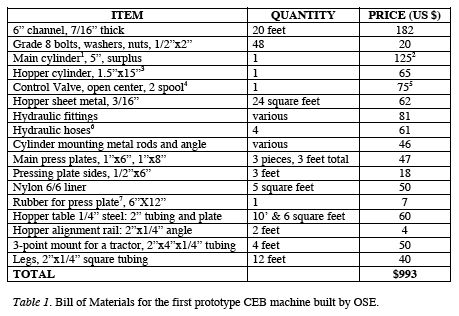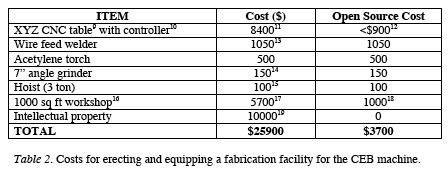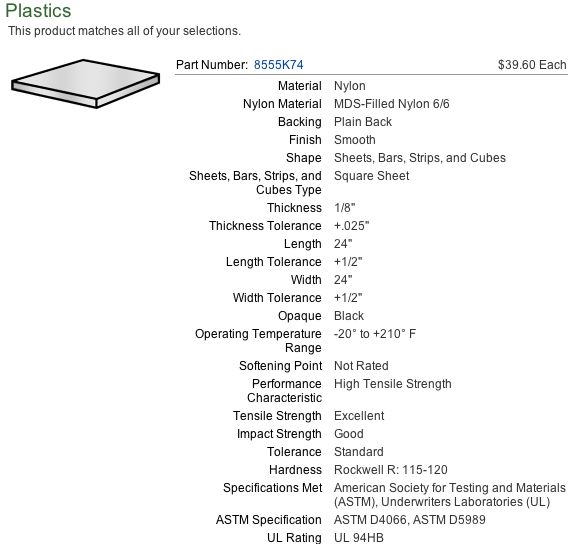Talk:CEB Press Bill of Materials
Here is the Bill of Materials (BOM) for the CEB prototype:
References:
- https://www.surpluscenter.com/item.asp?UID=2008010512293756&item=9-1143-08&catname=hydraulic
- Gotten from surplus.
- https://www.surpluscenter.com/item.asp?UID=2008010512293756&item=9-7156&catname=hydraulic
- https://www.surpluscenter.com/item.asp?UID=2008010512293756&item=9-6702&catname=hydraulic for $156
- Gotten from surplus.
- Item # 905-12120 and 905-1236 at https://www.surpluscenter.com/
- Item 8609K13 at http://www.mcmaster.com/
The main cylinder and control valve used were from surplus, so this price may rise by about $250 for the cylinder and $100 for the valve, for a total of about $1350 in readily-accessible parts. The total number of hours spent building this protoptype was about 140 hours. The time expected for fabricating the second prototype is 40 hours. Production runs are expected to take about 20 hours per machine, using an XYZ torch table for fabrication assist.
Fabrication Facility
Here are the capitalization requirements for fabrication capacity. The Cost column reflects the price structure if off-the-shelf tools and materials - and proprietary development procedures - are utilized. This cost is conservative, as intellectual property costs are probably higher than the $10k that was specified. The alternative route, or the Open Source Cost, is that which utilizes open source know-how and is built on a land-based facility. The open source option means that certain equipment may be fabricated readily from available components when a design and bill of materials is available.
References: 9. www.torchmate.com ; 10. Does not include the control computer; 11. Torchmate 3, http://www.torchmate.com/overview/index2.htm ; 12. http://bluumax.com/ ; 13. http://www.harborfreight.com/cpi/ctaf/displayitem.taf?Itemnumber=43550 ; 14. http://www.northerntool.com/webapp/wcs/stores/servlet/product_6970_200306001_200306001 ; 15. http://www.northerntool.com/webapp/wcs/stores/servlet/product_6970_18544_18544 ; 16. Not including land costs; 17. Cheapest barn kit: http://diypolebarns.com/pb_kits.php , more expensive: http://www.shelter-kit.com/b_prices.html ; 18. Using CEB construction with on-site soils, plus site-milled lumber leaves only doors, windows, foundation, and electrical costs of building; 19. This is difficult to estimate, but here we will include 200 hours of development work at $50 per hour- for producing 2 prototypes and testing prior to production runs.
In particular, the great cost reducer in the open source route is the availability of: (1) a low-cost XYZ table, (2), low cost workshop building, and (3), absence of intellectual property costs. In total, the price of putting together a fabrication facility is only $3700 if one has access to land, some kind of tractor or skid loader for material handling, and utilizes onsite building materials (CEBs and milled lumber) to construct the workshop space. It should be added that more labor will go into building an XYZ table than buying one, but not much more, if a transparent bill of materials and fabrication procedure is available. Workshop building time may also increase over the off-shelf option.
The XY table is a pricey solution if obtained off-the-shelf. New kits cost $8k at the low end for an industrial duty, 4x8 foot table. We should note that, as expected from the open source development method, ridiculously low costs are feasible for the CNC table. For example, a small CNC mill is under $200. The electronics of a CNC XY table are inexpensive. Three stepper motors plus controller and power supply cost $45. (http://bluumax.com/ - Note - these stepper motors are half the required size, so we expect the real price to scale accordingly.) Rails may be the expensive part, and other than that, it’s mostly a structure that can be fabricated via xyz bolt-together design. The CNC table should be accessible at <$500 plus structural steel at approximately $400. That is a Factor 10 reduction over the competition.
The cost structure for building a physical production facility for the CEB will be documented fully with forthcoming experience in 2008. We will be building this facility at Factor E Farm. Part of the development will be deploying an open source XYZ table, which we expect to cost <$900 in parts. There may be additional costs involved in finalizing a simple design for the XYZ table. The goal is a facility that can produce 1 CEB machine every 3 days with 1 fabricator working full time.
We will set up a social enterprise website to raise between $3700-5000 for deploying CEB machine fabrication. This site will designed to motivate the minimal funding of the facility, by directing as many potential stakeholders to the site as possible. Stakeholders include owner-builders interested in natural building, building organizations such as Habitat for Humanity, disaster relief organizations, building contractors, and a wide range of others. We are asking for collaboration in directing potential stakeholders to the funding website.
In summary, this is our first experiment of co-funding a significant production facility. Deployment funds will be used to build the facility, procure some tools, and build an open source version of the XYZ table. Utilizing existing collaboration, we will use up to $3k from the budget to design, build, and deploy the XYZ table. Together with Factor e Farm contribution of facility space, a fabricator who has already been recruited, and utilization of onsite materials for facility construction – we believe that we have an attractive package that can be funded. Costs and risk are distributed, and low overhead makes the entire project dirt cheap for the significance of the promised deliverable. It is a pressing issue (no pun intended) for us to deploy CEB machine production with 3-5 day delivery time – for proving a novel, state-of-art peer production mechanism.
Heavy Equipment
The balance of the budget for the open source CEB development is in materials handling and testing: a tractor with front end loader and rototiller. The tractor is required for soil preparation: digging soil and rototilling the soil to prepare it for use in the CEB machine. The tractor is also used to power the CEB machine for testing, and for material handling of raw steel that is used in the CEB machine. Moreover, we are presently utilizing a tractor to generate 20 kW of electricity by using a power take-off (PTO) generator. This powers the welder and other equipment, but we aim to replace this with a renewable power system as soon as we can. We currently run smaller electrical tools with a 3 kW inverter and a battery bank. These costs summarized are:
Notes: 1. We are considering an Allis Chalmers D17 Series IV Diesel tractor as a robust, all purpose tractor with good hydraulics
- Wear-resistant liner - MDS-Filled Nylon 6/6 from McMaster Carr



